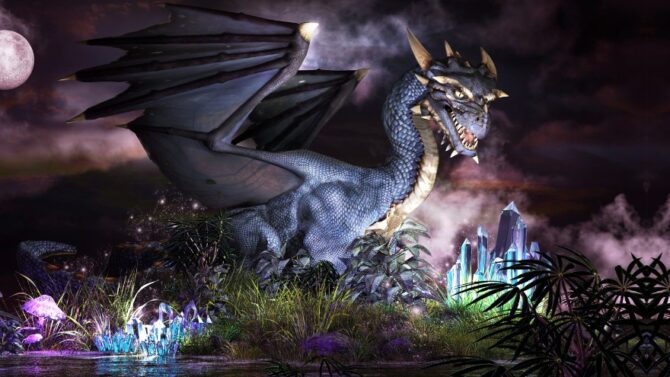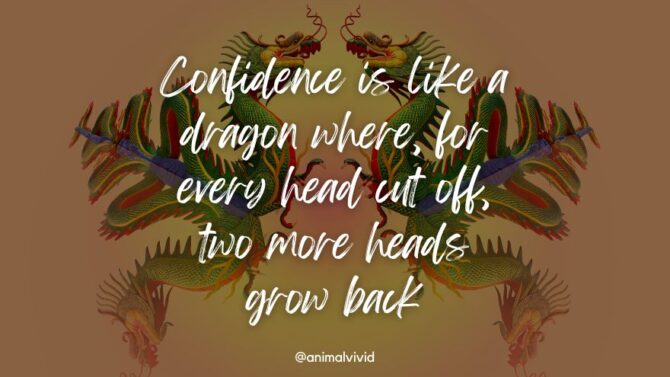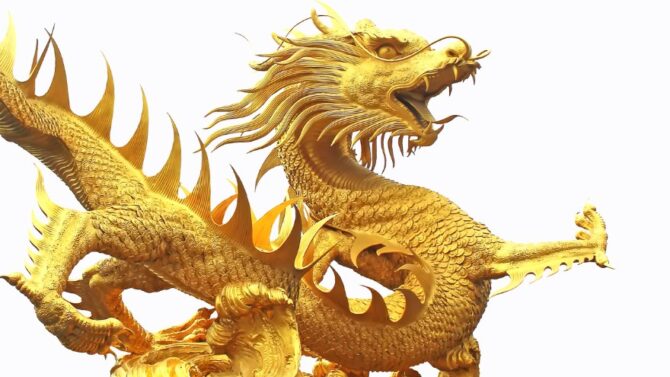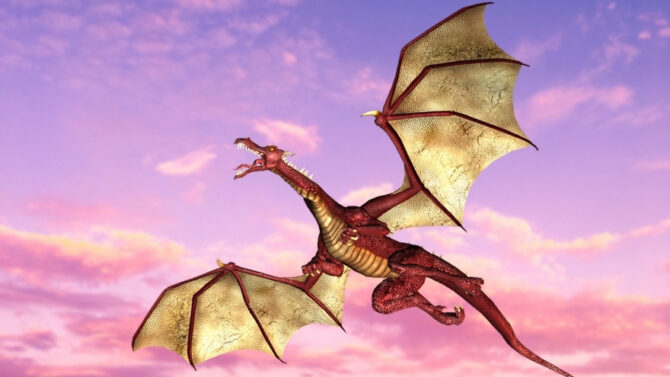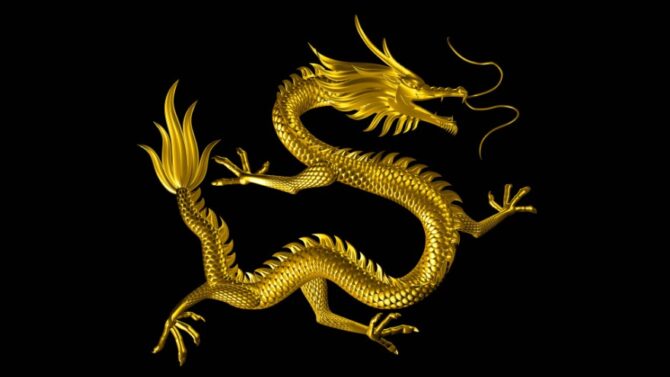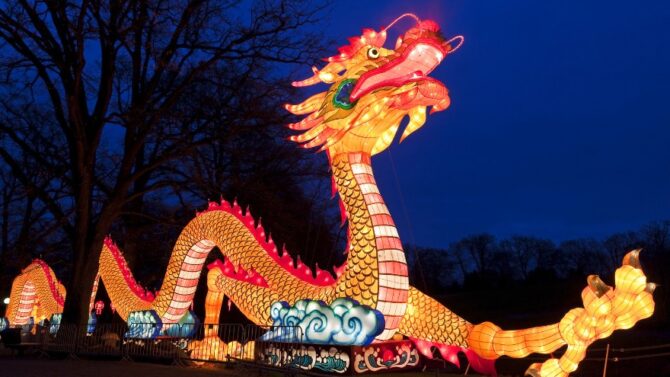There’s a lot to know about dragons, far more than their fire-breathing ability and flying.
Whatever you think you might know about this legendary reptilian creature, there are probably many more dragon facts you don’t know.
For instance, did you know the ideal way to kill a dragon is through the mouth? Or that dragons once acted like monkeys?
Let’s explore different legends and fun facts about dragons, covering all you need to know about this mythical creature, including why people believed it existed some years ago.
Read on to find out more.
Mind-blowing Dragon Facts & Legends
1. Dragons are more than a thousand years old
Mythical or not, one thing no one can deny is how long dragons have been with humans.
The first mention of these creatures was from the ancient Near East, and they were in ancient Mesopotamian art.
Different creation stories even featured dragons, like the Babylonian version.1
What is very amazing is how dragons didn’t fizzle out with time, as many other things do.
They are still fully represented in modern media and will be around for our kids and grandkids!
2. The word “dragon” stems from Greece
The word dragon is used in English today, but its roots are from the Ancient Greek word draconata, which means “to watch” or “to see.”
Given the ferocious reputation of this animal, one would expect the name to mean something along the line.
However, Ancient Greek mythology focuses more on the treasure-guarding aspect of dragons (more on this later), hence the name.
3. Dragons were once like monkeys!
Well, not in looks or behavior, just in the relationship with trees. Some lore did not show dragons as flying, fire-breathing animals, the kind we know of today.
Those dragons were flightless, and they used to remain on trees till they jumped on people’s heads, something a monkey would do.
Pliny the Elder put it well in his work Natural History: “The iaculus throws itself from the branches of trees; dragons are dangerous not only to the feet but also fly like a missile from a catapult.”2
4. Dragons were known around the world
Fewer mythical creatures were as widespread as dragons, and they appeared in the folklore of different places in the world. They were found in Africa, Europe, and Asia.
African folklore depicted dragons as otherworldly creatures. In Europe, they are villains to be slain by knights.
Asian folklore has a more positive view, especially in China.3
Some experts have theorized that the universal fear of snakes led to dragons being popularized all over the world.
5. Dragons are for fantasy. They’re hardly in sci-fi
In both ancient literature and modern times, dragons often appear in the fantasy genre alongside other creatures like elves, goblins, fairies, and dwarves.
A very good example is The Hobbit by JRR Tolkien.
However, dragons hardly feature in science fiction, especially the hardcore kind.
Of course, there have been many exceptions (we’re looking at you, Godzilla), but science fiction is often based on scientific theories and technological innovations.
6. Speaking of fantasy, there have been many famous dragons in modern times
As we said above, dragons won’t be disappearing from human literature anytime soon.
With more books written and medieval fantasy movies coming out of Hollywood, more fire-breathing creatures will be available for our entertainment.
Famous modern dragons include Smaug from The Hobbit, Dragon from Shrek (who got married to a donkey), and Norbert from Harry Potter.
7. They don’t look alike
Our popular image of dragons is often the European conception, but just as How to Train a Dragon reminded us, dragons come in different shapes and sizes.
Generally, it depends on what continent the story is coming out from.
Asian dragons look like big serpents and are often wingless. Most of them don’t breathe fire as they are more of sages than monsters.
European dragons vary in size, but they are generally more like lizards than snakes. They have limbs, wings, and fire-breathing qualities.
8. The Bible mentions dragons
Dragons are very old, and one proof of that is their appearance in the Bible, the Christian sacred text.
This is even more in the King James Version, especially in some parts of the Old Testament and in Revelation.
Some people may want to argue for the existence of dragons based on the Bible, but it’s more likely that the word translated as dragons referred to bigger serpents.
Dragons also symbolize evil and the devil.
9. Dragons do exist

Dragons really exist in modern times, but not the fire-breathing kind we see in myths and legends.
We’re talking about the Komodo dragon, and though it may not seem as cool as those in Game of Thrones, at least they are real.
Komodo dragons are endemic to the Komodo islands in Indonesia, as well as some other Indonesian islands like Rinca, Flores, and Gili Motang. It is a large reptile, and though it doesn’t breathe fire, it has its dangers.
10. Dragons in Game of Thrones were special
The epic series Game of Thrones got everyone talking, and it still is a subject of discussion even after its ending.
Viewers remember the dragons that appear on their screens. In some ways, they share similar characteristics with dragons from general Europe folklore.
For example, they breathe fire and are not easy to tame.
But there’s a trait unique to them. Dragons in this series never stop growing. However, the growth can be stunted when tamed.
11. Dragons had magic
And no, we’re not talking about breathing fire. As impressive as that quality is, it doesn’t qualify as magic in dragon lore but something more “natural.”
In many stories, these creatures had other qualities.
Some dragons could read minds. Others could control the elements of fire, water, earth, and air.
Some could even cast spells like true magicians. Some could speak, show wisdom, and have blood with magical properties.
12. There are people dedicated to studying dragons
Wouldn’t that be a great job to have? Maybe not for everyone, but if dragons were real, the institution concerned with handling them might have had an influx of resumes.
Those who study dragons are called dragonologists.
Professional dragonologists appeared in the Harry Potter series, but it’s not a real field of study.4
Then again, given that you’re reading an article on dragons, you might be a dragonologist!
13. It was illegal to sell dragon eggs in Harry Potter
If dragons were real, no doubt the sales of dragon eggs would have been illegal or at least highly regulated.
Dragons can be dangerous even in the Harry Potter world, and they have to be controlled.
Selling of eggs to private individuals would have a negative impact. Of course, that didn’t stop people from trading dragon eggs.
The sellers of dragons were called dragon dealers, and it was a shady business similar to dealing drugs.
14. Dinosaurs might have fostered belief in the existence of dragons
Due to how long dragons have been in myths and their widespread relevance, many experts of old treated dragons as real.
The first discovery of dinosaur fossils likely cemented the belief as there was no advanced technology to use and study.
Thus, given that dragons were already commonplace, it was assumed that the fossil belonged to the flying creatures.
However, further studies confirmed what we know now, that the fossils are that of dinosaurs.
There is no concrete evidence for dragons existing outside of mythology, at least not the big, powerful kind.
Dive Deeper: Dinosaurs vs. Dragons: What are the Differences and Similarities?
15. The dragon is the symbol of Wales
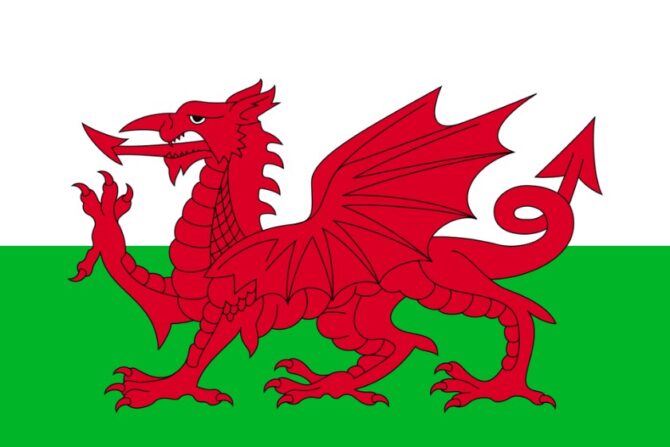
On the Wales flag is the drawing of a red dragon, and irrespective of how fictional dragons are, they are the national animal of Wales.
The red dragon is a huge part of Welsh culture, and this has been the case since 600 AD.
Wales likely chose the red dragon as a symbol of power and authority right after the Roman’s retreat from Britain.5
16. The United Kingdom and Ireland have many dragon stories
One reason why it was easy for Wales to adopt the red dragon as a national animal is because the region was already inundated with dragon stories.
Some examples are the water dragon in Lyminster, the red and white dragons, the dragon of Loschy Hill, and many more.6
If you’ve wondered why many European and American movies have dragons, here’s a good hint.
17. Many Catholic saints killed dragons
According to legends, at least. A notable example is Saint George, a Roman soldier who was venerated as a martyr in Christianity.
In the legend, the dragon was an extortionist who terrorized a village till the princess’s life was on the line. Saint George was able to defeat the dragon.
He wasn’t the only dragon-fighting saint in legends. Other examples are Margaret of Antioch, Philip the Apostle, and Saint Theodore of Amasea.
18. They are obsessed with treasure
Gold, silver, diamond, you name it. Dragons love treasure, and in many adventure stories involving treasure as the goal, the ultimate hurdle to cross is usually a large, frightening, fire-breathing dragon.
This seemed to have originated from Ancient Greek mythology.
The treasure-loving trait is still found in modern literature. Some examples are the guardians of the Gringotts vault in Harry Potter and Smaug in The Hobbit.
19. The female dragon is drakaina and the baby, a dragonet
In mythology, there are names used to designate a female dragon and a baby, much like we do for many other animals.
The female dragon is called a drakaina, stemming from the Ancient Greek drakon, the word for dragons. The little dragon is known as a dragonet.
According to many myths, dragonets, and drakainas are more dangerous than the male dragon.
The drakaina is protective of her young ones and would attack at the least provocation.
Dragonets are very impulsive, also making them dangerous.
20. The dragon breathes fire because of hell
Medievals portrayed hell as stepping into a monster’s mouth, and this inspired the famed fire-breathing quality of the dragon.
Fire-breathing dragons are often portrayed as villains, so a conflict with them is like a conflict between good and evil.
Not all dragons are fire-breathing, as we’ve already pointed out.
While it has become popular to see dragons fly and blow out fire (because it’s cool), many early depictions weren’t this way.
21. Dragons liked young women
In some stories, male dragons didn’t just have eyes for the draikana. They were also interested in young women as well.
This occurred more in stories of medieval times, where it was not uncommon for dragons to abduct princesses as treasure and knights to go after them.
Funnily enough, these dragons hardly hurt the princesses. They simply guard them.
At an age when women were seen as jewelleries, maybe the dragons weren’t wrong.
22. The Chinese love dragons
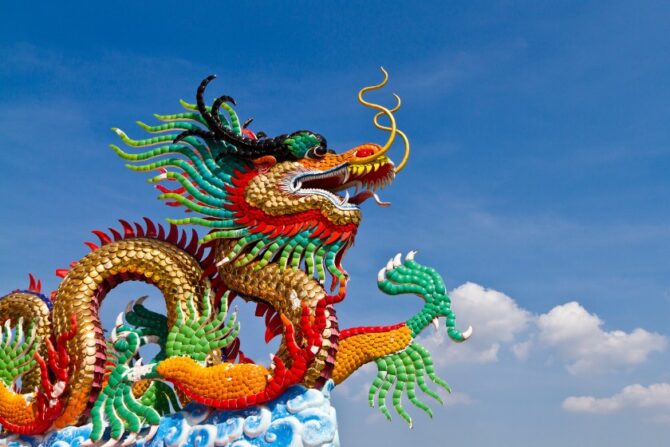
We’ve stated that China and many other Eastern folklore had a positive view of dragons, but it’s worth mentioning as a distinct fact.
Dragons are an integral part of the Chinese culture, and in many festivals, mascots often dress as these creatures.
Dragons also play a big role in some versions of the Chinese creation myth.
Rather than being a symbol of evil, dragons symbolized wisdom, prosperity, good fortune, and power.
Emperors used images of dragons to display leadership and power.
23. Chinese emperors were considered incarnations of dragons
Besides displaying power using dragons, Chinese emperors were also mystified and seen as incarnations of dragons.
This is due to the close association of dragons with these emperors. This is why they were robes with dragon designs.
The Chinese as a whole also consider themselves descendants of the dragons, which further ties these creatures to the Chinese identity.
24. According to Chinese mythology, there are different types of dragons and sons of dragons
Just as the European dragon comes in different types, there is also a variety of dragons in China.
These include the green, winged, coiling, underworld, and treasure dragons, among others.
A unique aspect of the Chinese perspective on dragons is that there are nine dragon sons. These sons serve as inspiration for paintings and decorations.
The nine sons are the Bixi, Qiuniu, Yazi, Chaofeng, Pulao, Chiwen, Bi’an, Suanni, and Fuxi.
25. Dragon colors also have meaning in Chinese mythology
European mythology has no use for dragon colors, as these creatures are simply meant to be defeated.
This is not so with the Chinese. Dragon colors have meaning in Chinese mythology.
The red color represents luck and good fortune, while the black stands for evil or revenge.
The white signifies purity, yellow for wisdom and power, then golden for prosperity and strength.
Finally, there’s the blue and green, which signify new life, spring, and plant growth.
26. The European and Chinese myths developed independently
A major reason for the differences in how Europeans and the Chinese view dragons is because their myths developed independent of each other.
European folklore is steeped in the evergreen battle between good and evil, and what better to represent evil than a ferocious, fire-breathing creature?
By contrast, the Chinese have a love for the elements, wisdom, quietness, and other virtues like leadership.
All these were incorporated into their folklore, including dragons. Dragons are also a part of Eastern religion, where they are positive symbols.
27. There are dragons in Africa too
We’ve looked into dragons in Europe and Asia, but our list of facts about dragons won’t be complete without looking into what dragons represented to Africans.
Their folklore evolved differently from the Europeans and Asians, so there are some differences. But this isn’t without some overlap.
Like other regions, African dragons are large, serpentine creatures. They are also otherworldly.
African dragons are usually neither evil nor portray highly positive qualities.
Two major examples of dragons in Africa are Apep in Egypt and the African rainbow serpent in West African countries.7 8
28. According to European mythology, the best way to kill a dragon is through the mouth
The European dragon was very powerful, and the scales on its body acted as an impenetrable weapon.
This was why facing a dragon became the ultimate test of courage for a knight. Defeating one was not an easy test.
The ideal way to kill a dragon was to get it through its mouth, its soft spot.
To do this, the knight needed a lance that he could throw. The very brave ones also try beheading, but that is hard!
29. Dragons were necessary for making wands in Harry Potter
Despite being under European lore, dragons in Harry Potter had some good use—though they were dangerous and considered untrainable.
Besides protecting the vault at Gringotts, these creatures were necessary for making wands.
The dragon heartstring was a core part of wand making, and without the dragon heartstring, the wand will be deficient.
We aren’t told what dragon type is more suitable for this, so we can assume there’s a variety to choose from.
Also, the name “heartstring” implies that it is taken from the heart, which raises the question of whether the dragon is alive or dead during the process.
30. Vikings had a relationship with dragons
Say hello to How to Train a Dragon. The animated movie centered around the conflict and eventual resolution of Vikings and dragons, touching on the fact that Vikings had a lot to say about dragons.
Norse mythology was rich, almost as much as others. It contained different creatures like giants, dwarves, strange horses, and wolves.
Added to this assortment of creatures are dragons. The latter in Norse mythology was viewed as objects of chaos and destruction. Raiding ships often had a dragon head as mast.
31. Toothless in How to Train a Dragon was special indeed
Toothless was a Night Fury, the rarest type in Berk and the fictional world in which it was based.
The coolest part about the Night Fury is that it is rare in dragon lore.
The Night Fury was created for the movie and was a creative process.
According to filmmakers, the Night Fury in looks is a combination of a black panther, a bat, and a small bird of prey.
Its behavior is inspired by more animals like cats, horses, dogs, and even the kangaroo.
32. Let’s talk about the Uroboros
The uroboros is also known as the ouroboros, and its use is widespread. It came into the West from Ancient Egypt and Greek.
The uroboros is a symbol of a dragon or a serpent eating its own tail. This symbol was used in alchemy and also in Gnosticism.
The uroboros stands for death and rebirth, making it a symbol of the circle of life.
33. Dragons in India are similar to that in China
Though dragons are not as revered in India the way the Chinese do, there are similarities between their depictions.
This shouldn’t come as a surprise, of course, given that they are both from the Eastern region.
Indians aren’t steeped into dragon lore (at least not like the Chinese), but they have some popular names.
A notable example is Vritra, the dragon in Hinduism that personified drought.9
34. Then there’s Japanese Dragons
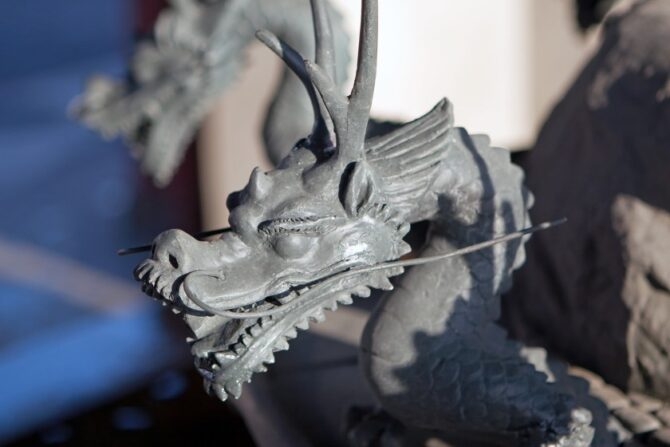
The Japanese conception of dragons leaned strongly on that of China, so there’s a lot of overlap between the two.
Just like the Chinese dragons, the Japanese version has three claws. It is also flightless and associated with positive signs like rainfall.
Like in every other culture, some dragons in Japan stand out. One example is Ryujin, known as a sea god, dragon king, or master of serpents.10
35. Let’s not forget the dragons in Australia!
Australia is associated with kangaroos and koalas, but real-life dragons are living in this region.
Of course, it’s not the dragons in mythology.
Australia is home to the bearded dragon, which is about as close as we can get to an actual dragon.
There are very few mythical dragons in Australia, but their mythology has room for these creatures.
Notable ones include the creator dragon Eingana and a dangerous Aranda.11 12
36. Dragons have their homes
Though dragons are fictional characters, they are well conceived such that they have preferred habitats, both in the European and Eastern versions.
In myths, it was unlikely for a character to meet a dragon in any other place besides its home.
Western dragons tend to live in castles, caves, or mountains. In castles, they might be kept secure in the dungeons, pending when they might be needed.
Eastern dragons are usually found around seas or floating in the skies.
37. Red-colored stones are sometimes called dragon stones
The name “dragon stones” was given to these red-colored stones because of an old belief that they were hardened lumps of dragon blood.
We know that is not true now, but the name has stuck.
Recall that dragon blood was said to have been special with healing properties.
Humanity would most likely have benefited from this if dragons did exist.
38. Children books have a different conception of dragons
We’ve established that dragons are villains in European mythology.
However, modern children books tend to portray a different picture, especially the comic kind.
Here, dragons aren’t monsters to be destroyed. They are rather harmless and even benevolent.
This strikes as similar to the Chinese perspective, except dragons in these books, are almost like pets.
An example is the classic Through the Looking Glass by Lewis Carroll, which features a Jabberwocky dressed as a gentleman.
39. Dragons have a long lifespan
How long do you imagine a dragon lives?
The answer depends on the specific mythology and dragon type.
But one aspect common amongst them is that they tend to live long, to the extent that in legends, they lived through civilizations.
A healthy dragon could live up to thousands of years, especially if they have magical powers.
Dragons are not usually immortal, though with their long lifespan, they appear that way.
Unfortunately (or sometimes fortunately), they do not live to the end of their days because they get killed by humans.
40. Dragons have fascinating eggs
Besides treasures and lonely princesses, dragons are known to guard their eggs jealously.
This is mainly due to their maternal instincts, but besides that, the eggs are also valuable.
Dragons lay up to 70 different egg types. It varies in size and looks depending on the dragon type, but in every story, dragon eggs are often special.
Some eggs are very small, much like a seed. Others get to the size of an adult chicken and could even rival that of an ostrich. Some are also very colorful.
Final Thoughts
There are many other dragon facts we couldn’t capture on our list (like them hissing while communicating).
However, you have enough to either kickstart you on the process of “dragonology” or add up to what you already know about these mythical creatures.
References & Notes
- Enuma Elish. Britannica.
- Pliny the Elder, The Natural History.
- Learn About Chinese Dragons. Chinese Language Institute.
- Dragonologist. Harry Potter Wiki, Fandom.
- Wales history: Why is the red dragon on the Welsh flag? BBC News.
- British Folklore: Ten Dragons. Norfolk Tales, Myths & More!
- Apophis. World History Encyclopedia.
- The Myth of the Rainbow Serpent. Study.com
- Vritra, Hindu mythology. Britannica
- Ryujin. World History Encyclopedia
- Eingana. Australian Aboriginal mythology.
- Aranda – Dragons of Fame. The Circle of the Dragon.
